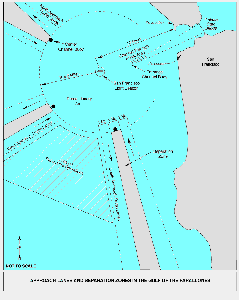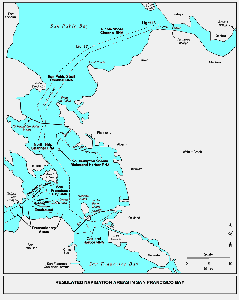





With its existing installations built to accommodate a 600-ship cold war fleet, the Navy's 320 ships and submarines are concentrated in `megaports' in Norfolk and San Diego, at the expense of closing installations in Orlando, Charleston and the San Francisco Bay area.
Vessel Traffic in San Francisco Bay has increased from approximately 87,000 movements in 1987 to an estimated 97,900 in 1995. Ferry vessel traffic represents approximately 68 percent of this total.
The Ports and Waterways Safety Act of 1972 authorized the U.S. Coast Guard to establish, operate, and maintain vessel traffic services for ports, harbors, and other waters subject to congested vessel traffic. As a result, in 1972 the Coast Guard established the Vessel Transportation Service (VTS) for San Francisco Bay and designated traffic lanes for inbound and outbound vessel traffic, specified separation zones between vessel traffic lanes, and set up rules to govern vessels entering and leaving ports. The VTS, which is located on Yerba Buena Island, controls marine traffic throughout the Bay Area. Although some small and private vessels are not required to coordinate their movements by contacting the VTS, the Coast Guard monitors all commercial, Navy, and private marine traffic within San Francisco Bay and local coastal waters.
West of the Golden Gate Bridge in the Gulf of the Farallones, approach lanes to the entrance of San Francisco Bay have been established from the north, west, and south. Each approach lane from seaward is composed of a 1-mile-wide inbound traffic lane and a 1-mile-wide outbound traffic lane with a 1-mile-wide separation zone between the traffic lanes. Outside these lanes, the US Navy has designated areas for submarine operations within which barge operations are precluded.
Piloting in and out of the Bay and adjacent waterways is compulsory for all vessels of foreign registry and US vessels under enrollment not having a federally licensed pilot on board. San Francisco Bar Pilots provide these services for vessel movements to and from all terminals in the Bay and tributaries to the Bay, including the Carquinez Strait. Ships bound for the San Francisco Bay and the Port of Oakland proceed in an easterly direction toward the Golden Gate Bridge through a narrow channel, which consists of inbound and outbound traffic lanes with a separation zone between them. These traffic lanes are 600 yards wide with a separation zone of approximately 150 yards.
Within San Francisco Bay the US Coast Guard has established RNAs (Regulated Navigation Areas) to increase navigational safety by organizing traffic flow patterns; reducing meeting, crossing, and overtaking situations between large vessels in constricted channels; and limiting vessel speed. The greatest hazard to vessel navigation is other vessel traffic. Large commercial and naval vessels are required by US Coast Guard regulations to use designated traffic lanes when traveling in inland waterways. Smaller commercial vessels (i.e., tugboats, ferryboats, and private vessels) often do not navigate within specific traffic lanes, but rather travel in the most direct route. These vessels can pose hazards to navigation, particularly if other circumstances such as fog are present. Fog occurs much of the time during the summer months, blowing in through the Golden Gate in the late afternoon and typically burning off by late morning.

